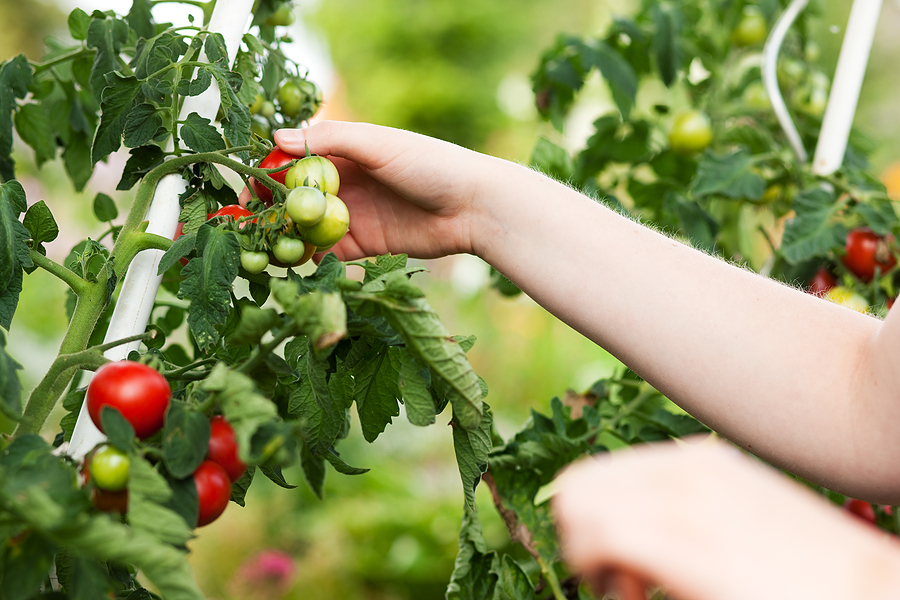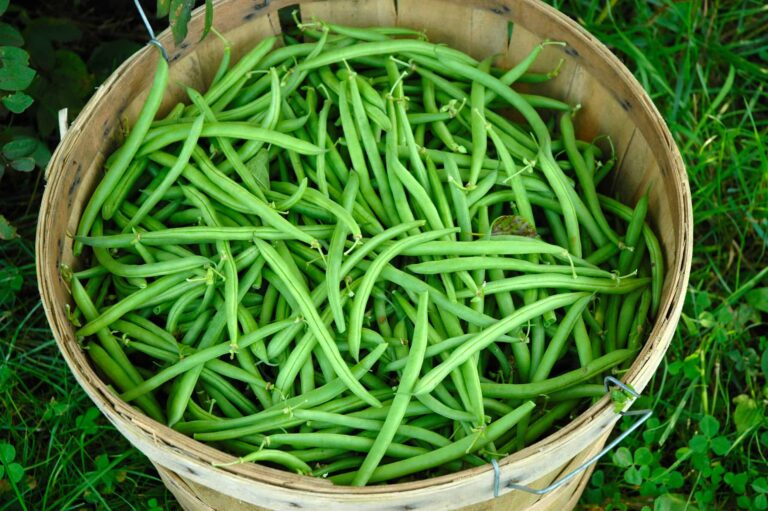When and How to Harvest Tomatoes for the Best Flavor
Harvesting tomatoes at the right time ensures the best flavor, texture, and nutritional value. Over the years, I’ve learned that picking tomatoes too early results in bland fruit, while waiting too long can lead to splitting or overripeness. The key is knowing what to look for and how to handle your tomatoes to get the most out of your harvest.
When to Harvest Tomatoes
Tomatoes are ready to pick when they reach full color and feel slightly firm yet yield a little to gentle pressure. Depending on the variety, this could mean deep red, bright orange, sunny yellow, or even a rich purple hue. I’ve found that vine-ripened tomatoes taste the best, but if pests or weather conditions threaten the crop, picking them when they first blush with color and allowing them to ripen indoors is a great alternative.
How to Harvest Tomatoes
Use garden scissors or pruners to cut the stem just above the fruit, or gently twist the tomato until it releases. Avoid pulling too hard, as this can damage the plant. If you’re harvesting a large number of tomatoes, place them in a shallow basket rather than stacking them to prevent bruising. For green tomatoes at the end of the season, store them in a warm, dark place to ripen, or use them in recipes like fried green tomatoes or chutneys.
Harvest tomatoes when the skin is slightly firm, shiny, and uniformly colored for the best flavor.
As a tomato ripens it will turn from a vibrant medium-green to a lighter shade, with faint pink or yellow stripes or flushing. Later the skin will mature to a uniform red or pink or yellow or white or green—depending on the variety.

How to Know a Red Tomato Variety Is Ripe
Tomatoes ripen from the inside out. As the tomato ripens (if the variety is a red one) the skin will turn from dark green to light green, to yellow, to yellow-orange, to pale pink or orange, to red. When the fruits are red, you’ll know the fruits are fully ripe. Not all tomatoes ripen evenly; some tomatoes including many heirlooms ripen to a variable degree of redness. As a tomato ripens, the skin will turn from dull to glossy.
The exact signs of tomato ripeness will vary from variety to variety.
- Harvest a tomato before its skin loses its waxy smoothness.
- Tomato flavor becomes more complex as the fruit ripens. Tomatoes ripen from the inside out.
- The optimal temperature range for tomato ripening is 68°F to 77°F (20°-25°C). Tomato ripening is slowed when temperatures are warmer or cooler than the optimum range. Tomatoes do not ripen at temperatures above 85°F (29°C).
- Green tomatoes that have reached three-fourths of their mature size can ripen off the vine. Place them in a paper bag with an apple or banana at room temperature out of direct sunlight; ethylene gas given off by the fruit will speed tomato ripening.
- If temperatures turn hot for an extended period, tomatoes on the vine will turn a yellowish-orange color and not be flavorful; in very hot regions, it is better to harvest tomatoes at the pink stage and ripen them at cooler temperatures indoors. More tips at How to Grow Tomatoes.
- In the fall when a frost or a freeze threatens, nearly mature green tomatoes can be picked and wrapped individually in newspaper and stored at room temperature in the dark until they ripen.
How to Tell if a Non-Red Tomato Variety Is Ripe
Not all tomatoes have red skins at harvest time. Here’s how to tell if a non-red tomato is ripe”
Pink tomato varieties
Pink tomatoes will have a yellowish or dusky pink cast to the skin as they ripen, Soon the tomato will take on a deep crimson-pink color. Pink (at maturity) tomatoes have clear skins with deep pink or red flesh beneath.
Yellow and orange tomato varieties
Yellow and orange tomatoes come in a continuum of colors from pale yellow to deep gold for the yellows and from pale orange to pumpkin for the oranges. Pick orange and yellow tomatoes as the color of each individual tomato intensified and as the skin turns from dull to bright and reflective–this is the mark of ripening. Some yellow tomatoes when re ripe will have pink blush at the bottom.
White tomato varieties
White tomato varieties turn from white to ivory with a slight yellow tinge as they ripen. The yellow tint of a ripe white tomato will be most pronounced at the tomato’s shoulder.
Black, purple, and dark brown tomato varieties
Black, purple, and dark brown tomatoes will deepen in color as they ripen and will turn from dull to bright and reflective. Purple, brown, or black tomatoes often have somewhat green shoulders when they ripen.
Striped and swirled tomato varieties
Striped and swirled tomato varieties will intensify in color as they ripen, that is the stripes and swirls will become more pronounced; the delineation of colors will emerge and deepen as the tomato ripens. The true intensity of colors will be most pronounced when the tomato is fully ripe.
Green tomato varieties
Green tomato varieties will become bright, reflective, and warm-looking as they ripen. A good hint that a green tomato is ripe is when its unripe dull, cold-looking skin disappears and becomes bright and reflective. Also, a green tomato that is ripe will yield a bit to a gentle squeeze.
Garden Planning Books at Amazon:
- Vegetable Garden Almanac & Planner
- Kitchen Garden Grower’s Guide Vegetable Encyclopedia
- Vegetable Garden Grower’s Guide
- Tomato Grower’s Answer Book

How to Harvest a Tomato
- Harvest tomatoes by cutting them from the vine with a garden pruner or sharp knife.
- Ripe tomatoes will often come off the vine with a simple twist. Don’t jerk or tug fruit from the vine. Apply slight pressure with your thumb where the stem and calyx join. The calyx is where the stem meets the fruit in a cuplike depression. Gently twist and break off the fruit.
How to Store Tomatoes
Store tomatoes at room temperature indoors (65°-70°F) or in a shady place outside. At room temperature, tomatoes will keep for 4 to 7 days.
- Don’t store or refrigerate tomatoes at temperatures below 55°F (13°C); this will cause flavor compounds to break down.
- Partially ripened tomatoes should not be refrigerated; refrigeration stops the ripening process.
- Ripe tomatoes that are refrigerated will lose their flavor and become overly soft.
- If tomatoes are refrigerated, put them in the crisper section of the refrigerator in a perforated plastic bag; the bag will keep the fruit from drying. Refrigerated tomatoes will lose color, firmness, and flavor.
- Tomatoes can be frozen, canned, or dried for future use. To freeze tomatoes, just wash them, cut out bad spots, and place them on a baking tray in the freezer. Once frozen, store tomatoes in plastic freezer bags until needed.
- Periodically check stored tomatoes to remove ripened fruit beginning to decay.
How to Freeze Tomatoes
You can freeze extra tomatoes for use in winter. Frozen tomatoes are best used in cooked dishes as freezing will cause them to lose their firmness. Here are two ways to freeze tomatoes:
- Place whole or peeled tomatoes in a plastic freezer bag and freeze. (To peel a tomato, place it in a strainer and pour boiling water over it for 5 seconds. The peel will pull away easily. You can also place a tomato in boiling water for 45 seconds, then plunge it in ice water for several seconds before peeling.) When ready to use, allow frozen tomatoes to come to room temperature.
- Tomato purée can also be frozen. Cook or steam tomatoes in a little water until soft. Mash the fruit through a press or wire strainer or whirl in a blender; add sugar and or lemon juice to taste; heat to boiling; chill and pack.
Tomato Growing Hub
Start here: The Ultimate Tomato Growing Guide: From Seed to Harvest
Growing Tips
- Getting Started with Tomatoes: A Gardener’s Guide to Success
- How to Choose a Tomato for Your Garden
- Growing Early-Season Tomatoes for Great Taste
- Heirloom and Hybrid Tomatoes
Planting Tips
- Tomato Seed Starting Tips
- Mastering Tomato Seed Starting: How to Grow Strong and Healthy Plants Indoors
- When to Plant Tomatoes: A Gardener’s Guide to Timing and Success
- Plant Tomatoes for a Thriving Crop: Sun, Soil, and Spacing
- How to Transplant Tomato Seedlings: A Gardener’s Guide
- Growing Tomatoes in Containers
Tomato Care
- Watering and Feeding Tomatoes: Expert Tips for a Healthy, Productive Crop
- Best Ways to Support Your Tomato Plants
- Pinching and Pruning Tomatoes: A Gardener’s Guide to Healthier, More Productive Plants
- How to Prune Tomatoes
- Grow Tomatoes on Stakes
- Best Companion Plants for Thriving Tomatoes: What Works & What to Avoid
Pest & Disease Control
- Tomato Growing Problems: Pests, Diseases, and Solutions
- How to Prevent Blossom Drop — Tomatoes and Peppers
- How to Identify Early Blight, Late Blight, and Leaf Spot on Tomatoes
Harvest & Preparation
- When and How to Harvest Tomatoes for the Best Flavor
- How to Ripen Tomatoes
- Planting Tomatoes for a Long Harvest
- Planting Tomatoes for a Fall Harvest: How to Grow Fresh Tomatoes Before Frost
- Tomato Flavor Explained
- Nine Ways to Cook and Serve Tomatoes
Garden Planning Books at Amazon:
- Tomato Grower’s Answer Book
- Vegetable Garden Almanac & Planner
- Kitchen Garden Grower’s Guide Vegetable Encyclopedia
- Vegetable Garden Grower’s Guide
Books to help you grow:
- Vegetable Garden Almanac & Planner
- Kitchen Garden Grower’s Guide Vegetable Encyclopedia
- Vegetable Garden Grower’s Guide
- Tomato Grower’s Answer Book
More harvest tips:
Learn when and how to harvest your favorite vegetables for the best flavor and texture. Get storage tips for each crop. Click on the vegetable you are growing below.
- Artichoke
- Arugula
- Asparagus
- Beans
- Beets
- Broccoli
- Brussels Sprouts
- Cabbage
- Cantaloupe — Melons
- Carrots
- Cauliflower
- Celery
- Chard
- Collards
- Corn, Sweet
- Cucumbers
- Eggplant
- Endive and Escarole
- Garlic
- Jerusalem Artichoke
- Kale
- Kohlrabi
- Leeks
- Lettuce
- Melons
- Okra
- Onions
- Parsnips
- Peas
- Peppers
- Potatoes
- Pumpkins
- Radicchio
- Rhubarb
- Rutabaga
- Spinach
- Squash, Summer
- Squash, Winter
- Sunchokes
- Sweet Potato
- Swiss Chard
- Tomatillo
- Tomatoes
- Turnips
- Watermelon







